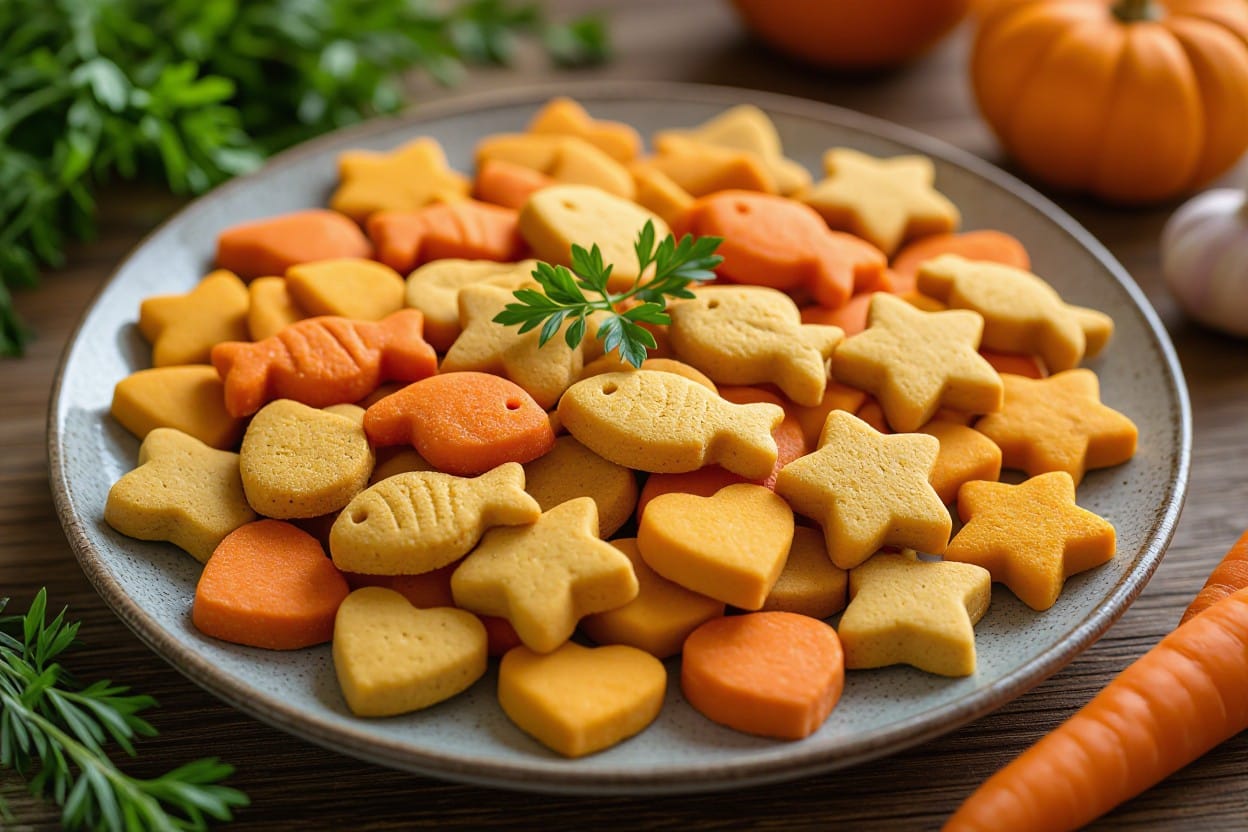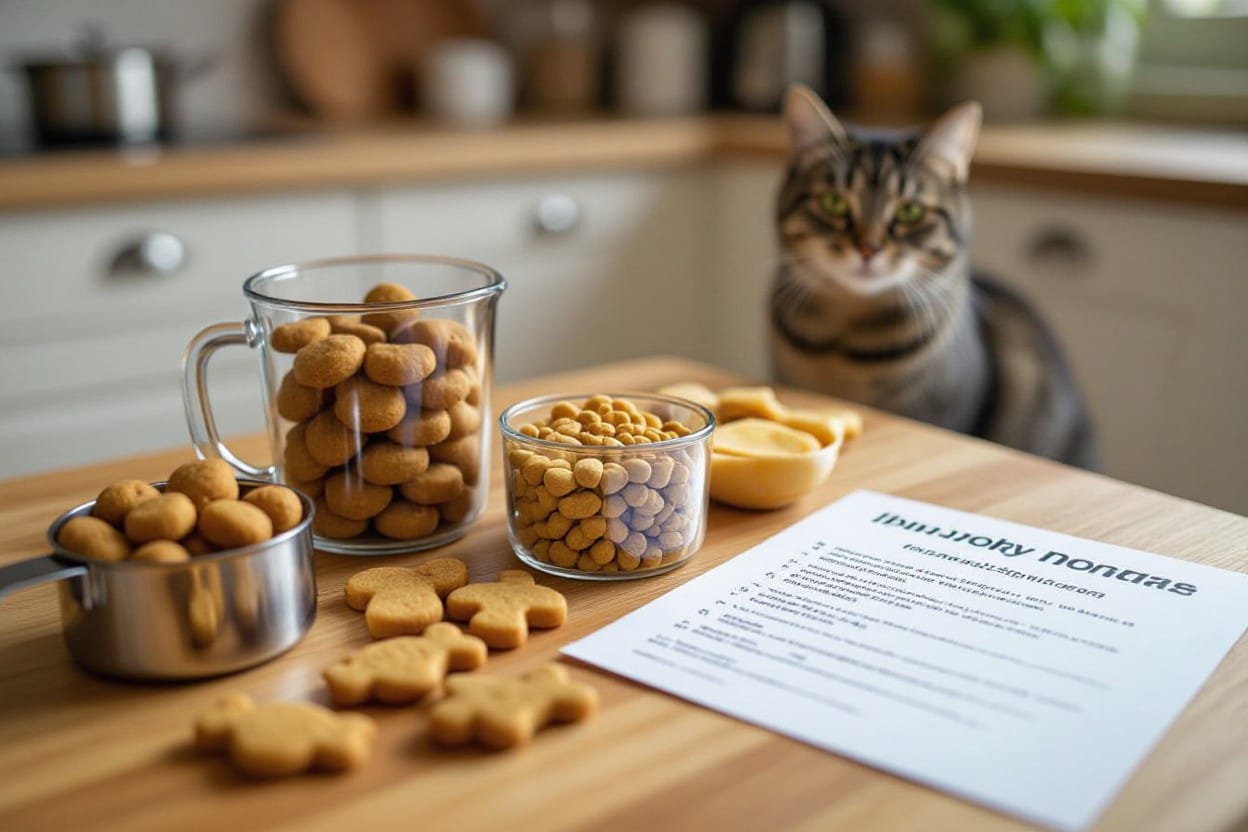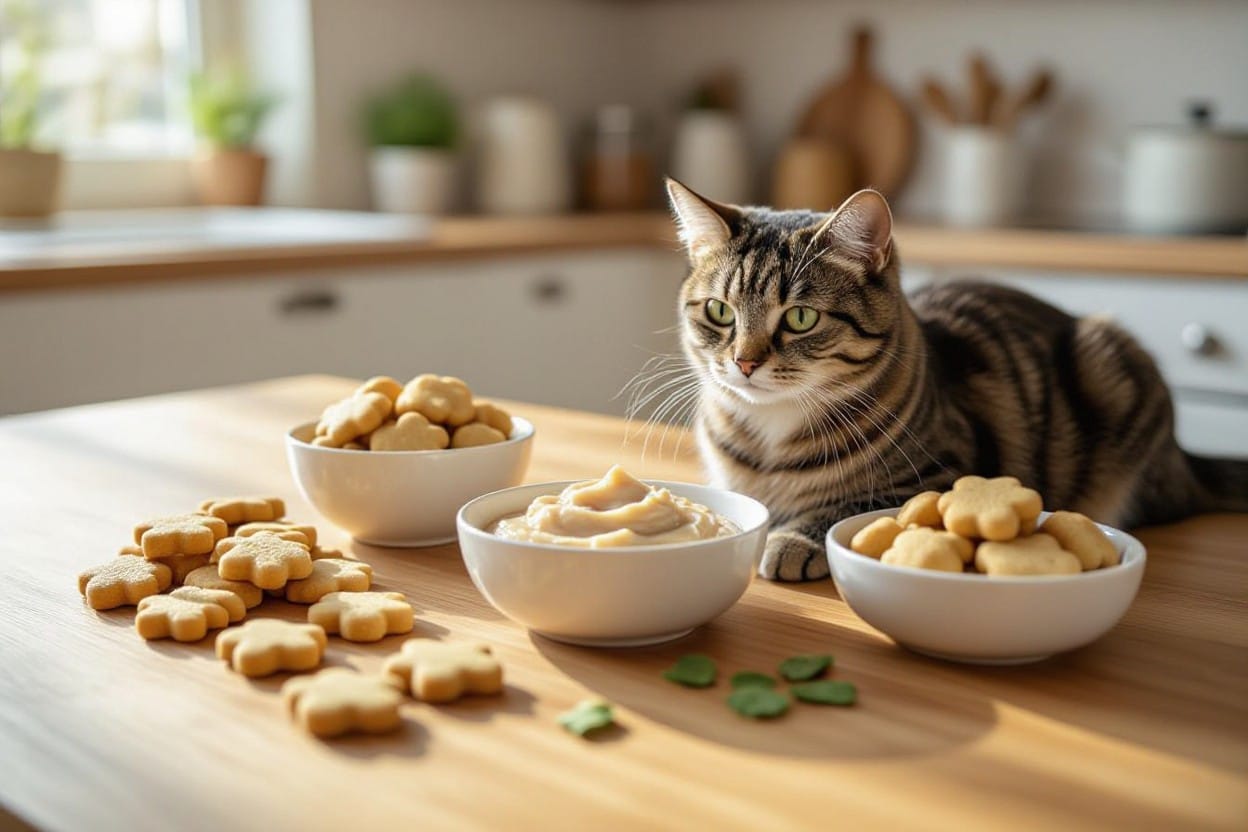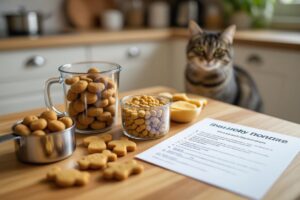Most of your cat’s well-being benefits when you make easy protein rich cat treats homemade; with these easy homemade cat treats and simple cat treats recipes you’ll learn beginner cat treats methods including 3 ingredient cat treats options that are fast and nutritious, while you must avoid toxic foods like onion, garlic, chocolate to keep your pet safe. You’ll follow clear steps to boost protein intake, control ingredients, and confidently treat your cat without specialty skills.
Key Takeaways:
- Easy homemade cat treats: 10 protein-rich, beginner cat treats and simple cat treats recipes that include many 3 ingredient cat treats for quick, wholesome snacks.
- Focus on high-quality protein (chicken, tuna, salmon), vet-safe ingredients, and minimal prep to support feline health and palatability.
- Batch, freeze, and portion treats for freshness; use keyword-rich labels like “easy homemade cat treats” and “easy protein rich cat treats homemade” to boost SEO.
Understanding Cat Nutrition
The Role of Protein in a Cat’s Diet
Protein provides the imperative amino acids your cat cannot synthesize, because your cat is an obligate carnivore. Adult maintenance diets generally target around 26–30% crude protein on a dry matter basis, while growing or reproducing cats often need closer to 30% or higher. High-quality animal proteins—chicken, turkey, tuna, salmon, and eggs—supply bioavailable amino acids including taurine, whose deficiency can lead to dilated cardiomyopathy and retinal degeneration.
When you create easy homemade cat treats, prioritize lean cooked meats and whole-animal protein sources. Aim for treats that boost protein without exceeding daily calorie limits: keep treats to less than 10% of daily calories (for a typical adult cat of 180–250 kcal/day, that’s roughly 18–25 kcal from treats). Simple formulations like 3-ingredient cat treats—cooked chicken, canned tuna (in water), and a beaten egg—are both beginner-friendly and protein-rich.
Essential Nutrients for Feline Health
Beyond protein, your cat needs specific fats, vitamins, and minerals that are unique to felines. Dietary arachidonic acid and preformed vitamin A and D must come from animal tissues because cats poorly convert plant precursors. Amino acids such as taurine and arginine are non-negotiable; even small deficiencies of arginine can cause a dangerous rise in blood ammonia within hours.
Mineral balance matters when you prepare homemade items: calcium-to-phosphorus ratios should be roughly 1:1 to 2:1 if you’re including ground bone or bone meal. Excessive sodium, added flavorings, or unbalanced minerals can create long-term health issues, so treats should be small, periodic, and based on named animal ingredients rather than fillers.
More info: If you plan to make frequent protein-rich treats, use commercially available feline multivitamin/taurine supplements as recommended by your veterinarian to avoid gaps. Small batches using cooked chicken breast, a pasteurized egg, and a trace mineral supplement will maintain nutrient density while preventing imbalances that arise from repeatedly feeding a single homemade recipe.
Understanding Commercial Cat Treats vs. Homemade
Commercial treats offer convenience, shelf stability, and consistent guaranteed analysis labels—look for a high “crude protein” percentage and named meat sources near the top of the ingredient list. Low-cost mass-market treats often contain grains, soy, or cellulose as bulk fillers and may show crude protein values as low as 10–20%, while higher-quality treats typically range from 30–50% protein on a dry basis.
Homemade treats let you control protein quality, exclude fillers, and create easy protein rich cat treats homemade with minimal ingredients. Food safety trade-offs include handling raw meat and correct cooking: cook poultry to 165°F (74°C) internal temperature and avoid raw fish/eggs due to bacterial risk and enzyme-related vitamin losses. Always track treat calories—many commercial single-piece treats are ~3–10 kcal each—so you can compare to your cat’s daily 180–250 kcal target.
More info: When choosing between store-bought and DIY, use this checklist—verify crude protein on the label, prefer named animal proteins (chicken, salmon, tuna), avoid “meat by-products” as the first ingredient, and for homemade batches keep portions tiny (pea-sized) and log their calories. Combine that approach with simple cat treats recipes and beginner cat treats methods to make safe, protein-focused rewards without upsetting your cat’s overall nutrition balance.
Benefits of Homemade Cat Treats
Control Over Ingredients
Making your own treats lets you pick single, identifiable ingredients—lean cooked chicken, canned tuna in water, plain pumpkin, or whole eggs—so you know exactly what your cat is eating. You can create easy homemade cat treats like simple 3-ingredient cat treats (tuna + egg + oat flour) that prioritize protein and omit fillers often found in commercial snacks.
That control also means you can actively exclude harmful items: avoid onions, garlic, chocolate, and any products with xylitol. You can reduce added salt, skip artificial preservatives and fragile fillers, and tailor textures for kittens, adults, or seniors to lower choking or dental risk.
Cost-Effectiveness of Homemade Treats
Buying bulk proteins and basic pantry staples turns into big savings: a 2 lb pack of boneless chicken breast (roughly $6–$8 depending on region) can yield dozens of small treats, bringing the cost per treat under $0.10 in many cases versus $0.50–$1.00 for comparable commercial treats. Using inexpensive staples like canned tuna, eggs, and oat or rice flour keeps ingredient costs low for beginner cat treats.
Batch-making and freezing portions further stretches your budget; a single baking session can produce 6–8 weeks of snacks for one cat. Using leftovers (boiled turkey breast from dinner, a flaked salmon fillet) cuts waste and lowers effective cost per serving while still delivering high-protein bites.
Factor in equipment: a basic baking sheet and silicone mat or muffin tin is a small one-time expense (roughly $10–$20) that quickly pays back through lower per-treat costs. Scaling recipes up reduces the time and cost per treat further—double or triple a tested simple cat treats recipes batch and freeze the extras to maximize savings.
Customized Nutrition for Your Cat
Custom recipes allow you to emphasize high-protein ingredients to meet feline needs—adult cats typically require diets with at least about 26% crude protein for maintenance and around 30% for growth/reproduction according to standard feeding guidelines—so you can craft easy protein rich cat treats homemade that complement your cat’s daily intake. Use cooked chicken, turkey, salmon, or eggs as base proteins and adjust portion size so treats remain snack-sized (few grams each).
Allergies and sensitivities can be managed by choosing single-source proteins: if your cat shows a reaction to chicken, switch to rabbit or duck in small test batches. You can also lower phosphorus or sodium and add easily digestible carbohydrates for senior cats with specific needs, while avoiding ingredients that worsen urinary or kidney conditions.
Adding supplements is possible under veterinary guidance: a vet-recommended taurine supplement, a small dose of fish oil for coat health, or controlled calcium for bone support can be mixed into treats to meet individual requirements—this level of tailoring is difficult to achieve with off-the-shelf snacks.
Safety First: Preparing Cat Treats
Ingredients to Avoid
Avoid common human ingredients that are toxic or harmful to cats: onions, garlic, chives, xylitol (found in some sugar-free products and peanut butters), chocolate, caffeine, and alcohol. Cooked bones can splinter and cause intestinal perforation or choking, and raw dough can expand in the stomach; both should never be used in your easy homemade cat treats. Raw eggs and raw fish carry bacterial risks (Salmonella) and thiaminase activity that can deplete vitamin B1 over time.
High-fat scraps and very salty foods increase the risk of pancreatitis and sodium toxicity; keep fat content low and avoid added salt. Dairy often causes diarrhea due to lactose intolerance in adult cats, so plain milk-based ingredients are best left out of simple cat treats recipes unless you know your cat tolerates them.
Common Allergens in Cats
Beef, dairy, fish, and chicken top the list of protein-related reactions in cats, with grains like wheat or soy occasionally triggering sensitivities. Veterinary estimates place food-related adverse reactions in a small percentage of the population (about 1–3% overall), but they can account for a higher share of chronic skin or GI problems you might see during practice.
Signs of a food allergy include persistent itching, frequent ear infections, chronic vomiting or diarrhea, and excessive grooming leading to hair loss. Elimination diet trials using a novel protein or hydrolyzed diet for 8–12 weeks remain the diagnostic gold standard; allergy blood tests often give false positives and are less reliable.
To narrow down triggers while making beginner cat treats, use single-protein, limited-ingredient recipes (even 3 ingredient cat treats) and introduce new treats one at a time for 7–14 days while logging symptoms; that log will help you detect delayed or cumulative reactions.
Vet Consultations: Ensuring Safety
Consult your veterinarian before adding regular treats if your cat has kidney disease, diabetes, pancreatitis, or food sensitivities. Vets can run baseline bloodwork, calculate safe portion sizes, and advise whether a novel-protein or hydrolyzed diet is needed; target treats to under 10% of daily calories—for example, a 10 lb (4.5 kg) indoor neutered cat typically needs ~180–200 kcal/day, so treats should total no more than ~18–20 kcal.
Discuss any new ingredient you plan to use in your easy protein rich cat treats homemade, especially unconventional proteins like rabbit or venison, as cross-reactivity can occur. If you suspect an allergy, your vet will likely recommend a supervised elimination trial rather than relying solely on at-home testing kits.
Veterinary support can also help you formulate balanced, low-risk treat recipes, provide guidance on safe cooking methods (fully cooked, deboned proteins), and advise when to avoid raw preparations due to bacterial or parasite risks.
Essential Tools and Equipment
Kitchen Tools You’ll Need
You’ll want a digital kitchen scale (accuracy to 1 g) for portion control and consistent results in your easy homemade cat treats; measuring cups, a set of measuring spoons, and a reliable set of mixing bowls make scaling simple cat treats recipes easy. A high-speed blender or food processor helps you turn canned tuna, cooked chicken, or salmon into smooth pastes for 3 ingredient cat treats, while a fine-mesh sieve or small deboning tweezers removes stray bones and fibers before mixing.
For baking and shaping, use rimmed baking sheets lined with parchment or silicone mats, silicone molds for soft, protein-rich bites, and a cooling rack to prevent sogginess. Optional but helpful: small cookie cutters for uniform portions (expect ~24 bite-size treats per standard sheet for many beginner cat treats), a piping bag for precise dosing, and an oven thermometer so you hit the exact temperature your recipes call for.
Food Storage Options
Store freshly baked or prepared treats in airtight containers in the refrigerator for short-term use—most protein-rich homemade cat treats will keep well for 3–5 days at 40°F (4°C). Portion into small containers or resealable bags so you only open a single serving at a time, which preserves texture and reduces spoilage risk for your easy homemade cat treats.
For longer storage, freeze treats flat on a tray for 1–2 hours, then transfer to labeled, freezer-safe bags or vacuum-seal pouches; frozen treats remain high-quality for about 3 months at 0°F (-18°C), and vacuum sealing can extend shelf life to ~6 months. Thaw in the refrigerator overnight rather than at room temperature to keep bacterial growth in check.
Choose freezer-safe materials—silicone molds, BPA-free plastic containers, or heavy-duty freezer bags—and label each batch with date and ingredients so you can track batches of beginner cat treats or 3 ingredient cat treats you make repeatedly.
Cleaning and Sanitizing Basics
Wash all equipment that touches raw protein with hot, soapy water and a dedicated brush, then sanitize either in the dishwasher on a high-heat cycle or with a bleach solution of 1 tablespoon unscented bleach per gallon of water; allow items to air dry. Use separate cutting boards for raw proteins (fish, poultry) to prevent cross-contamination and the risk of pathogens like Salmonella.
Keep sponges, dishcloths, and scrub brushes fresh: replace or sanitize them frequently—microwaving a damp sponge for 60 seconds or running it through the dishwasher can reduce microbes—and swap sponges out about every 2 weeks if you’re making treats regularly. Silicone molds and utensils tolerate high-heat sanitation, so use the dishwasher sanitize cycle when possible.
Avoid leaving protein-rich treats at room temperature more than 24 hours; if you handle multiple batches, wipe surfaces with the bleach solution between sessions and inspect stored treats for off-odors or mold before serving to your cat.
Treat Recipe #1: Chicken and Pumpkin Bites
Ingredients
1 cup cooked, shredded chicken (white meat preferred), 1/2 cup canned pure pumpkin (not pumpkin pie filling), and 1 large egg to bind. For slightly firmer texture you can add 1–2 tablespoons oat flour or finely ground oats if needed; this keeps the recipe among the top “3 ingredient cat treats” with a simple optional binder.
Use fully cooked chicken (no raw) and pure pumpkin only — do not use pumpkin pie filling because of added sugar and spices. Cooked chicken contains about 31 g protein per 100 g, so these bites are an easy protein-rich cat treats homemade option ideal for beginner cat treats recipes.
Preparation Steps
Preheat your oven to 350°F (175°C). Pulse the chicken and pumpkin in a food processor until a cohesive paste forms, then add the egg and pulse until evenly mixed. Scoop rounded 1/2-inch portions (about 3–4 g each) onto a parchment-lined baking sheet so you get roughly 30–40 small treats per batch.
Bake for 10–14 minutes depending on size; smaller bites need about 8–10 minutes while slightly larger pieces may take up to 15 minutes. Cool completely on a rack — the centers will firm as they cool, and you should achieve a chewy yet set texture suitable for most adult cats.
Oven temperatures vary, so test one treat first to dial in time: cut it open to ensure no raw pockets remain and that the interior is evenly cooked. For a no-bake alternative, dehydrate at 140°F (60°C) for 4–6 hours until firm; you can also freeze dough portions and bake later.
Serving Suggestions
Offer 1–3 small bites per day for an average adult cat, keeping treats under 10% of daily calories. Each 1/2-inch bite is roughly 5–8 kcal and provides a protein boost — at about 1–2 g protein per treat — making these a high-protein option among simple cat treats recipes.
Store freshly baked bites in the refrigerator for up to 4 days or freeze in an airtight container for up to 3 months; label with the date. Discard immediately if you see mold or detect a sour smell, and always introduce new treats slowly over 2–3 days to monitor for digestive upset or allergies.
Use these treats for training by breaking them into tinier pieces, sprinkle crumbled bits over wet food to encourage picky eaters, or warm a single bite briefly to enhance aroma during medication time. Adjust portions if your cat is overweight or has special dietary needs.
Treat Recipe #2: Tuna and Oatmeal Delights
Ingredients
1 can (5 oz / 140 g) tuna in water, drained and flaked; 1/2 cup (45 g) rolled oats (pulse to a coarse flour if you want a smoother texture); 1 large egg to bind. This is a true 3 ingredient cat treats option that keeps the recipe in line with other easy homemade cat treats and delivers a high-protein bite (tuna provides roughly 20–25 g protein per 100 g).
Choose tuna in water with no added salt and avoid tuna in oil or with flavorings. Never add onions, garlic, chives, or xylitol to the mix — those are toxic to cats. Yield: about 30 pea-sized treats or 10–12 larger bite-sized pieces, making this a practical easy protein rich cat treats homemade option for beginners.
Preparation Steps
Preheat your oven to 350°F (175°C) and line a baking sheet with parchment. Mix drained tuna, oats, and egg in a bowl until combined; if you want a finer texture, pulse the tuna and oats briefly in a food processor first. Scoop pea-sized portions (about 1/2 teaspoon) onto the sheet, flatten slightly, and bake for 8–10 minutes until firm and lightly golden at the edges.
Let the treats cool completely on a rack before offering them to your cat. For air-fryer preparation, cook at 320°F (160°C) for 6–8 minutes and check frequently. Adjust texture by adding up to 1 tablespoon plain Greek yogurt or a splash of water if the dough is too dry, or another tablespoon of oats if too wet.
Store baked treats in the refrigerator for up to 5 days or freeze in portions for up to 3 months; thaw in the fridge overnight. Limit tuna-based treats to no more than 1–2 times per week due to potential mercury exposure, and give only 1–2 small treats per training session to keep overall caloric intake balanced.
Serving Suggestions
Offer treats as training rewards or scatter a few on a puzzle feeder to encourage activity; your cat will respond well to the strong tuna aroma, so warm a treat for a few seconds in the microwave (10–15 seconds) to boost appeal. For kittens or small adults, keep portions to about 1/2 teaspoon per treat and avoid replacing regular meals with treats.
Crumble a treat over wet food as an occasional topper (no more than once a week if the main diet already contains fish) or use them whole for clicker training sessions—they’re ideal for short, frequent rewards because they’re small and protein-rich.
Freeze single-serve portions in an ice cube tray or silicone mold to control portions and thaw as needed; gently warming a frozen treat for a few seconds releases scent and can help entice picky eaters while maintaining portion control.
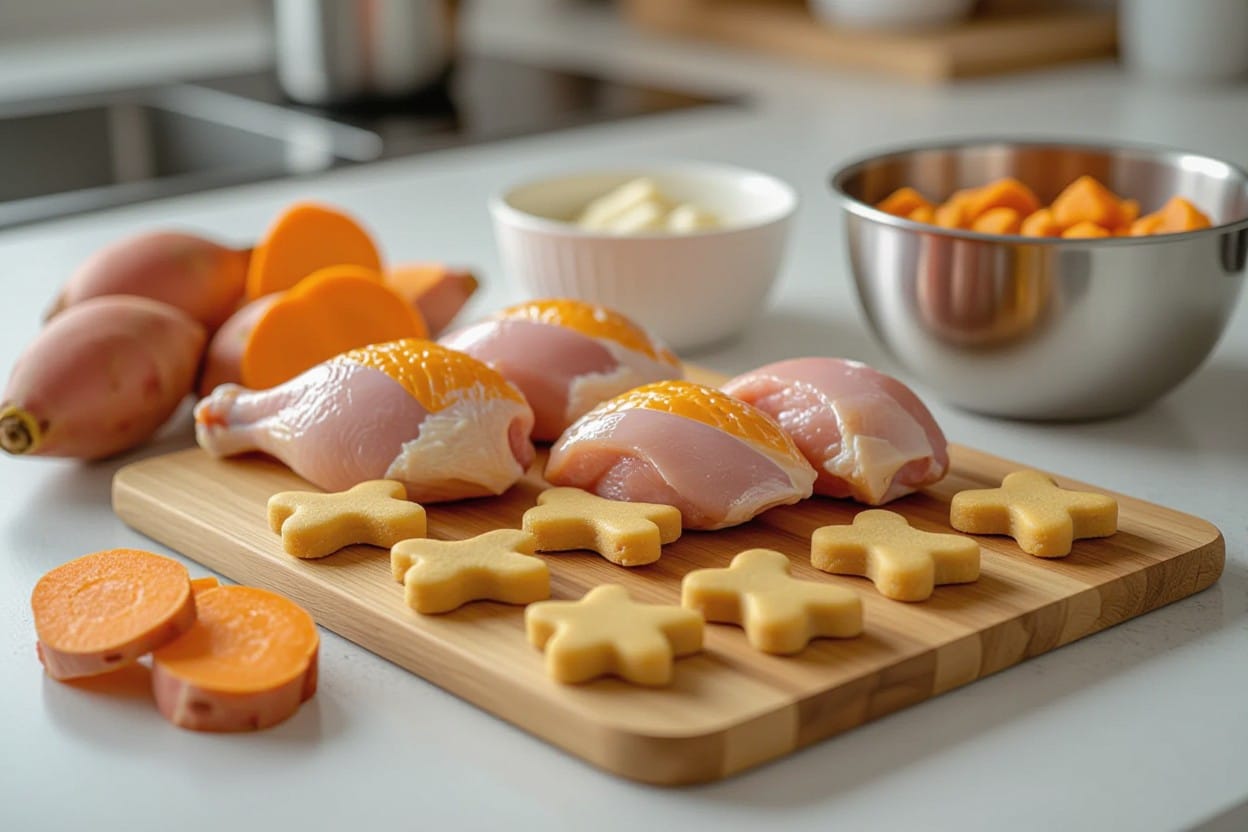
Treat Recipe #3: Turkey and Sweet Potato Chews
Ingredients
1 cup cooked lean turkey (shredded, no skin, no bones), 1/2 cup cooked mashed sweet potato (plain, no added salt or sugar), and 1 large egg — a true set of 3 ingredient cat treats that deliver lean protein and fiber. These quantities make about 25–35 small chews; turkey supplies the bulk of the protein while sweet potato adds palatable sweetness and binding starch.
Optional: 1–2 tablespoons oat flour if the mixture is too wet. Avoid any onion, garlic, seasoning blends, salt, or broths with added sodium — these are dangerous for cats and must not be used in your easy homemade cat treats.
Preparation Steps
Preheat the oven to 325°F (163°C). In a bowl mash turkey and sweet potato together, then mix in the egg until evenly combined; add oat flour a tablespoon at a time if needed to reach a firm, moldable consistency. For bite-sized chews drop teaspoonfuls onto a parchment-lined sheet (yield ≈ 30 small chews) or roll between two sheets of parchment to about 1/8–1/4 inch thick and cut into small strips.
Bake for 12–15 minutes for soft chews or 20–25 minutes for firmer, crunchy chews, flipping once halfway to brown both sides. Allow chews to cool completely on a wire rack before serving; hot pieces can burn your cat’s mouth and texture changes as they cool.
If the mixture is too sticky, add 1–2 tbsp oat flour; if too dry, stir in 1 tsp unsalted turkey broth or water. Store in the refrigerator up to 5 days or freeze portions for up to 3 months; the recipe yields treats at roughly 10–15 kcal per small chew, so portion accordingly.
Serving Suggestions
Use these turkey chews as high-value training rewards or scatter a few inside a puzzle feeder to stimulate hunting behavior. For kittens or small cats break pieces into smaller bits; for a 10 lb cat (approx. 200 kcal/day), keep treats under 10% of daily calories — about 1–3 chews daily depending on size.
Warm a chew for 5–10 seconds in the microwave to release aroma for picky eaters, or crumble a chew over wet food as a protein-rich topper. Avoid offering chews to cats with known turkey allergies or those on veterinary elimination diets without consulting your vet.
Watch senior cats or those with missing teeth: softer, shorter-baked chews reduce choking risk and dental stress, while firmer chews can help with light dental abrasion for healthy adult cats.
Treat Recipe #4: Salmon and Spinach Squares
Ingredients
You will need 1 cup cooked, flaked salmon with all bones removed, 1/4 cup cooked and finely chopped spinach (squeeze out excess moisture), 1 large egg, and 1/2 cup oat flour (or a gluten-free substitute). For a true easy homemade cat treats option, swap cooked salmon for 1 cup low-sodium canned salmon in water and keep the egg and 1/2 cup oat flour for a quick 3 ingredient cat treats variant.
Salmon provides roughly 20–22 g protein per 100 g cooked, so this recipe delivers a high-protein snack for your cat. Use plain, unsweetened yogurt (1 tbsp) as an optional binder and skip any seasonings — avoid onions, garlic, chives, xylitol, and added salt.
Preparation Steps
Preheat the oven to 350°F (175°C). Steam or blanch spinach for 1–2 minutes, then cool and squeeze dry. In a bowl mix flaked salmon, chopped spinach, egg, and oat flour until a moldable dough forms; if using canned salmon drain thoroughly before mixing. Press the dough into a parchment-lined mini baking sheet to about 1/2-inch thickness and cut into 1/2-inch squares (expect ~20–24 squares). Bake 12–15 minutes until set and lightly golden, then cool completely on a wire rack.
If the dough is too wet add 1 tablespoon more oat flour at a time; if too dry add 1 teaspoon water or the optional 1 tablespoon plain yogurt. For bite-size training treats, cut smaller and reduce baking to 8–10 minutes — monitor firmness so they don’t over-bake and become brittle.
Prevent cross-contamination by using separate utensils and a cleaned surface for fish; discard any salmon juices and refrigerate unused cooked salmon within 2 hours. Do not serve raw salmon due to parasite and bacteria risk, and store baked squares in the fridge up to 3 days or freeze up to 3 months.
Serving Suggestions
Offer 1–2 squares per small cat as a treat, keeping total treats under 10% of daily calories — most 1/2-inch square salmon treats will be ~6–10 kcal each. Use them as rewards during short training sessions, crumble over dry food for a palatable topper, or hand-feed for bonding; rotate with other simple cat treats recipes like chicken bites to avoid flavor fatigue.
Introduce these squares slowly: give one and watch for GI upset or allergic reactions for 24–48 hours. Cats with known fish sensitivities should avoid salmon and instead try the chicken-and-pumpkin or turkey alternatives from earlier recipes in this series of beginner cat treats.
Store portions in an airtight container in the fridge and thaw frozen treats in the refrigerator overnight or at room temperature for 20–30 minutes before serving; discard any uneaten treat left out over 2 hours.
Treat Recipe #5: Liver and Rice Crisps
Ingredients
1 cup cooked, finely chopped chicken or beef liver, 1/2 cup cooked white rice (well mashed), and 1 large egg to bind — a true 3 ingredient cat treats approach that keeps this recipe in easy homemade cat treats and beginner cat treats. Add 1 teaspoon fish oil or a pinch of dried catnip if you want to boost palatability; omit any seasonings and avoid onions, garlic, chives at all costs.
Preparation Steps
Pulse the cooked liver and cooked rice in a food processor until mostly smooth, then stir in the beaten egg to form a spreadable dough; this yields about 30–40 small crisps if you shape them into 1/2-inch rounds. Preheat the oven to 325°F (160°C), drop spoonfuls onto a parchment-lined baking sheet, flatten slightly, and bake for 18–22 minutes until firm and lightly browned — flip halfway for even drying. For a dehydrator method, spread in thin patties and dehydrate at 145°F for 4–6 hours until crisp.
Make sure you cook liver thoroughly (internal temp ~165°F) before blending to eliminate pathogens, and test one crisp for texture before committing to a full batch; if your mix is too wet add a teaspoon of rice flour or extra mashed rice to firm it up. This simple technique keeps the recipe within the easy protein rich cat treats homemade niche while staying part of your broader collection of simple cat treats recipes.
Serving Suggestions
Offer one small crisp as a high-protein reward during training or as an occasional topper on dry food; because liver is extremely rich in vitamin A, limit servings to a few small crisps per week for adult cats or no more than 1–2 per day only if your vet agrees. Store finished crisps in the refrigerator up to five days or freeze portions in a zip bag for up to three months to keep you stocked for quick rewards.
Introduce these treats gradually if your cat has a sensitive stomach and track overall vitamin intake from commercial foods so liver treats remain a nutritious boost rather than a dietary overload; this keeps your practice aligned with best practices for easy homemade cat treats and responsible feeding.
Treat Recipe #6: Beef and Carrot Treats
Ingredients
1 cup cooked, finely chopped lean beef (use 93% lean or trim visible fat), 1/2 cup grated carrot, 1 egg to bind, and 1/4 cup oat flour (or almond flour for grain-free). Add 1 teaspoon fish oil or a pinch of cat-safe powdered nutritional yeast as optional flavor boosters. This combination keeps the recipe in line with easy homemade cat treats and works well as a protein-forward, beginner-friendly option.
Avoid seasoning and any ingredients from the onion/garlic family; onions and garlic are toxic to cats. Also avoid giving raw beef due to bacterial risk—use fully cooked beef and cool it before mixing to keep these easy protein rich cat treats homemade safe for your cat.
Preparation Steps
Preheat oven to 350°F (175°C). Combine the chopped cooked beef, grated carrot, egg, and oat flour in a bowl; mix until you have a pliable dough—add 1–2 tablespoons water or low-sodium chicken broth if too dry. Roll the dough to about 1/8 inch thickness, cut into small bite-sized shapes (about 1/2 inch squares), and place on a parchment-lined baking sheet.
Bake for 12–15 minutes until edges are firm and center is set; yield is roughly 25–35 small treats depending on size. Let them cool completely before serving or storing. Use lean, fully cooked beef and avoid added salts or spices to keep these part of your collection of simple cat treats recipes.
For a smoother texture that picky eaters prefer, pulse the beef and carrot in a food processor before mixing; this also helps you make consistent, training-friendly sizes. If you need to extend shelf life, refrigerate for up to 5 days or freeze in portions for up to 3 months—thaw in the refrigerator and bring to room temperature before offering.
Serving Suggestions
Offer these as occasional rewards: aim for treats to stay under 10% of your cat’s daily calories. For an average 8–12 lb cat, that usually means no more than 3–4 small treats per day; break treats into halves or quarters during training to stretch servings. Use them as high-value reinforcers for grooming, nail trims, or new-skill training.
Serve at room temperature and avoid sprinkling human condiments. Monitor your cat for any signs of upset after first exposure—introduce one piece and watch for 24 hours. These fit well into a rotation of beginner cat treats and work nicely alongside single-ingredient freeze-dried proteins for variety.
If your cat has a history of food sensitivities, offer these treats on non-consecutive days and track reactions in a simple log; swapping oat flour for almond or coconut flour can help with grain sensitivities while keeping the recipe within the scope of 3 ingredient cat treats-style simplicity.
Treat Recipe #7: Sardine and Coconut Balls
Ingredients
1 can sardines in water (about 3.75 oz / 106 g), drained and flaked; 1 large egg; 1/4 cup unsweetened shredded coconut; 1/3 cup oat flour (optional binder). This combination gives you an easy protein rich cat treats homemade option with omega-3s from the sardines and a mild flavor cats usually love. If you want to keep it as true 3 ingredient cat treats for a very simple approach, omit the oat flour and rely on the egg, but expect a softer texture that benefits from chilling.
Choose sardines packed in water with no added salt or seasonings — avoid varieties in brine, oil with flavorings, or any labeled with garlic/onion. Use unsweetened coconut and check labels to avoid products containing xylitol. This recipe yields about 12–16 small 1/2-inch balls, making it a practical entry in your collection of easy homemade cat treats.
Preparation Steps
Preheat your oven to 325°F (163°C). Drain and flake the sardines, removing any large bone fragments (soft bones are generally edible). In a bowl combine the flaked sardines, the egg, shredded coconut, and oat flour if using; mix until a slightly sticky dough forms. Scoop tablespoon-sized portions and roll into 1/2-inch balls, placing them on a parchment-lined baking sheet.
Bake for 10–12 minutes until the balls are set and lightly golden; allow them to cool completely on a rack so they firm up. If you prefer a no-bake route, swap the egg for 1 teaspoon coconut oil as a binder, shape the mixture, and chill in the refrigerator for at least 1 hour — keep in mind the baked version cooks the egg and gives the most consistent texture.
Adjust texture by adding up to 2 tablespoons more oat flour if the mix is too wet, or a teaspoon of the reserved sardine liquid if too dry. Store cooled treats in an airtight container in the fridge for up to 5 days or freeze portions for up to 2 months; thaw in the fridge before serving. Aim for small portions — each ball is roughly 8–12 kcal, so treat intake should stay within about 10% of your cat’s daily calories.
Serving Suggestions
Use these as high-value training rewards (one or two balls per session) or crumble a ball over wet food as a protein-rich topper. Strong aroma makes them effective for picky eaters; keep portions small and supervise multi-cat households to ensure fair sharing. Seal leftovers tightly in the fridge to minimize odor transfer.
Freeze single-serve balls in paper-lined trays so you can pop out one at a time and thaw overnight. Offer sparingly — once or twice a week is a good starting point — and consult your vet before regular feeding if your cat has kidney disease or sodium-restricted diet, since fish-based treats can be higher in phosphorus and sodium. This recipe fits well among your simple cat treats recipes and beginner-friendly lists for beginner cat treats makers looking for protein-packed options.
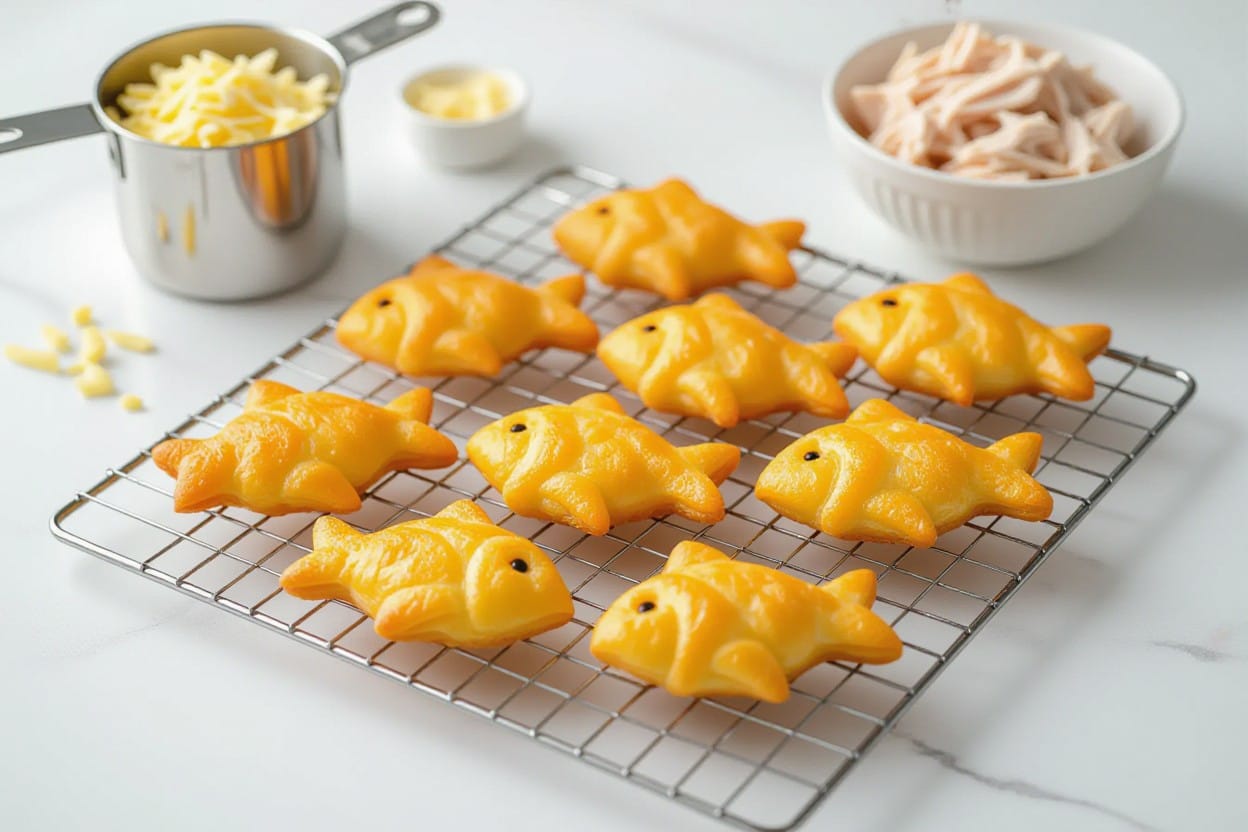
Treat Recipe #8: Chicken and Cheese Puffs
Ingredients
Gather 1 cup (about 140 g) cooked, shredded chicken breast, 1 large egg, and 2 tablespoons (≈30 g) low-lactose cottage cheese or mild grated cheddar. Add 1–3 tablespoons oat flour only if the mixture needs binding; this keeps the recipe close to the spirit of easy homemade cat treats and the popular 3 ingredient cat treats approach.
Avoid any seasonings or additives: do not use onions, garlic, chives, or salt. Make sure the chicken is cooked to an internal temperature of 165°F (74°C) to eliminate bacterial risk; using pre-cooked plain chicken can save prep time and reduce handling.
Preparation Steps
Preheat the oven to 350°F (175°C) and line a baking sheet with parchment paper. In a bowl, mix the shredded chicken, egg, and cheese until a slightly sticky dough forms; stir in 1 tablespoon oat flour at a time if the mix is too wet. Use a ½ teaspoon scoop to portion small puffs (aim for 30–40 small treats from this batch) and place them about 1/2 inch apart on the sheet.
Bake for 10–12 minutes until the edges are lightly golden and the tops feel firm to the touch; these puffs won’t rise dramatically but will set into bite-sized morsels. Let them cool completely on a wire rack before offering to your cat so the centers finish firming and any residual heat dissipates.
Batch yields contain roughly 50–55 g total protein (≈43 g from the chicken + egg and cheese), so each small puff provides approximately 1–1.5 g protein—a compact, protein-rich snack for training or rewards. Store in the fridge up to 5 days or freeze portions for up to 1 month; thaw in the refrigerator and only reheat gently to room temperature before serving.
Serving Suggestions
Offer these puffs as high-value training rewards—break into pea-sized pieces for repetitive sessions or give whole puffs for single-reward situations. Limit treats to a few per day depending on your cat’s calorie needs; for an average 10 lb (4.5 kg) indoor cat, keep extra snacks to under 10% of daily calories and adjust meal portions accordingly.
Use the puffs to encourage activity by hiding them in puzzle feeders or scattering a few around a play area to promote natural foraging behavior. Kittens and senior cats benefit from smaller pieces; slice or crumble to control portion size precisely.
Warm a puff briefly (just to room temperature) to boost aroma for picky eaters, or crumble a couple over wet food as a protein-rich topper. Always monitor for any digestive upset the first few times you introduce a new homemade treat and adjust serving size if your cat shows sensitivity.
Treat Recipe #9: Duck and Pea Treats
Ingredients
1 cup cooked, shredded duck (about 140 g), 1/3 cup cooked mashed peas (about 50 g), 1 large egg, and 2–3 tablespoons oat flour (or finely ground oats) to bind. Yield: roughly 30 small training-size treats (each ~1–2 g). This is one of the best easy protein rich cat treats homemade options because duck delivers concentrated animal protein and the egg adds additional amino acids.
Use plain, unsalted duck and plain peas with no additives; avoid any seasoning. Dogs and people use garlic and onion powders frequently, but for your cat avoid onions, garlic, chives, and xylitol at all costs because they are toxic. This recipe fits well into lists of easy homemade cat treats and simple cat treats recipes for beginner cat treats makers.
Preparation Steps
Preheat your oven to 350°F (175°C). Cook and shred the duck (or use leftover cooked duck without bones or skin). Steam or boil the peas until soft, then mash or pulse in a food processor until smooth. In a bowl mix shredded duck, mashed peas, and the egg; stir in oat flour 1 tablespoon at a time until the mixture holds together but remains slightly sticky.
Line a baking sheet with parchment, scoop teaspoon-sized portions (or use a small cookie cutter for uniform shapes), place them 1/2 inch apart, and gently flatten. Bake for 12–15 minutes until the centers are set and edges are lightly golden. Let cool fully on a rack before handling.
Check that any poultry reaches a safe internal temperature of 165°F (74°C) during cooking. If you prefer lower-moisture, longer-lasting treats, dry them in a dehydrator at low heat or bake an extra 10 minutes at 275°F (135°C) to crisp; cool completely before storing.
Serving Suggestions
Offer these as small rewards during training or hide-and-seek play; break into pea-sized bits for frequent reinforcement. Keep treats to under 10% of your cat’s daily caloric intake—for a 9–10 lb (4–4.5 kg) cat that’s roughly 20–30 kcal from treats per day, so limit portions accordingly. These qualify as simple 3 ingredient cat treats with an added binder, ideal for quick training sessions.
Freeze extras in single-portion bags and thaw a few at a time; refrigerated treats will keep 3–4 days, frozen up to 2 months. Use a thawed treat as a topper for wet food or crumble a few over meals to boost protein and palatability for picky eaters.
Introduce the new treat gradually—offer one or two pieces and watch for loose stool or vomiting for 48 hours. If your cat has fat-sensitive pancreatitis, kidney disease, or known protein sensitivities, consult your vet before making duck a regular treat option.
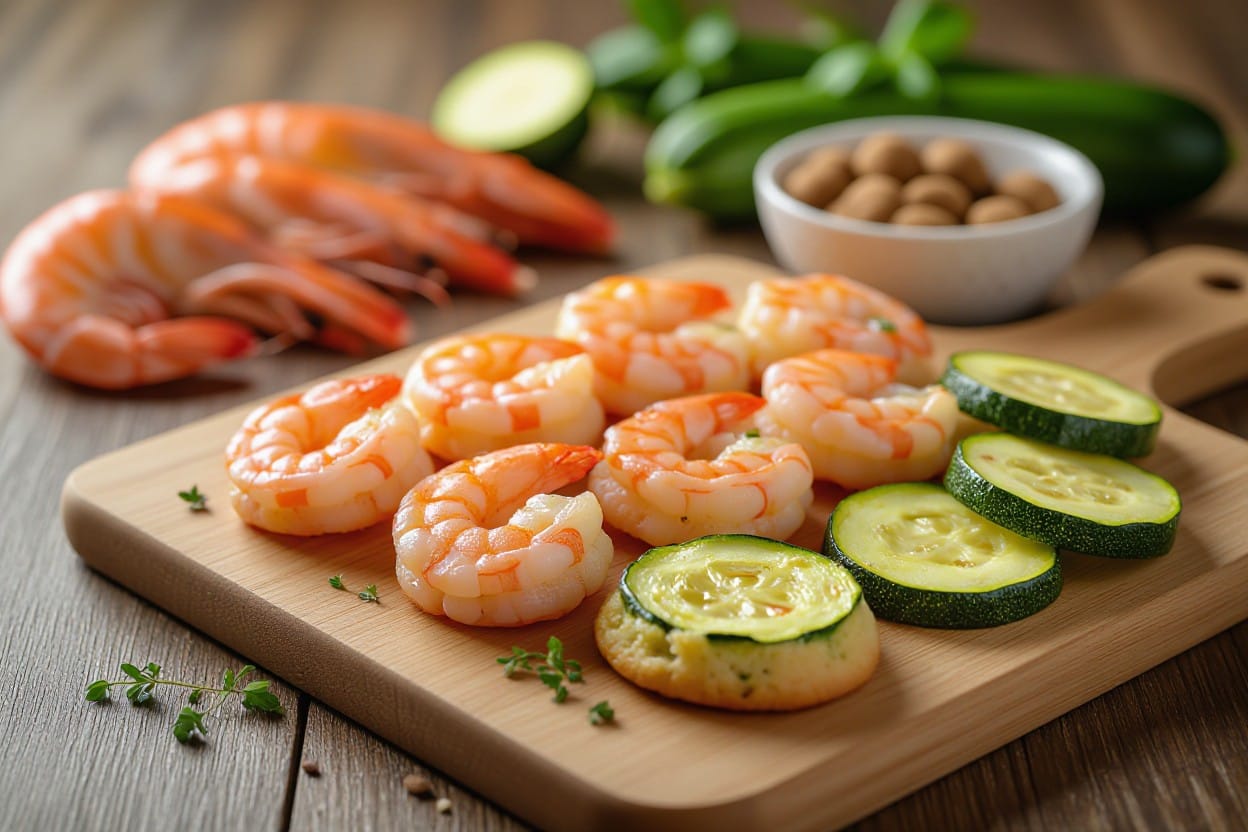
Treat Recipe #10: Shrimp and Zucchini Cookies
Ingredients
1/2 cup cooked, peeled, deveined shrimp (finely chopped), 1/3 cup grated zucchini (squeezed of excess water), 1 large egg, 1/2 cup oat flour (or pulse 1/2 cup rolled oats into flour). Use plain, unseasoned shrimp; do not include shells, tails, or any onion/garlic seasoning — those are dangerous for cats.
Yields about 24 one‑inch cookies depending on size. If you prefer a true “3 ingredient cat treats” version, skip the oat flour and add a second egg to bind (cookies will be softer). Substitute coconut flour sparingly (start with 1–2 tbsp) if you need grain‑free options.
Preparation Steps
Preheat oven to 350°F (175°C). Combine chopped shrimp, squeezed zucchini, egg, and oat flour in a bowl; mix until a spoonable dough forms. If the mixture is too wet, add oat flour 1 tablespoon at a time; if too dry, add a teaspoon of water or a small pinch of grated zucchini. Ensure shrimp were cooked through beforehand and fully peeled — raw shrimp and shells can cause illness.
Scoop level 1/2 teaspoon portions (about 1 inch) onto a parchment‑lined baking sheet and flatten slightly. Bake 10–12 minutes until edges firm and centers set, then cool completely on a rack. Store in the refrigerator up to 5 days or freeze up to 3 months.
Pulse the shrimp briefly in a food processor for a uniform texture if your cat prefers smooth treats; this also helps disperse tiny pieces of shell if any slipped through. Adjust thickness by testing one cookie first — a 10–12 minute bake at 350°F usually yields a firm, bite‑size cookie; add 2–3 minutes for larger pieces.
Serving Suggestions
Break into small pieces for training or reward; give 1–2 small cookies per session for most adult cats. Treats should stay under 10% of daily calories — an average adult cat requires ~200–250 kcal/day, so limit treats to approximately 20–25 kcal total per day.
Use crumbled cookies as a wet‑food topper or mix a few into puzzle feeders to extend play and enrichment. Warm a cookie for 5–7 seconds in the microwave to release aroma for picky eaters, but avoid overheating.
Introduce shrimp slowly to your cat’s diet: offer one small piece first and watch for vomiting, diarrhea, or signs of allergy over 24–48 hours. If your cat has a known seafood allergy or you’re unsure, consult your veterinarian before offering these easy protein rich cat treats homemade.
Summing up
From above, you can see that easy homemade cat treats provide a practical way to boost your cat’s protein intake while keeping full control over ingredients and portion sizes. The 10 recipes are beginner-friendly, showcasing simple cat treats recipes and several 3 ingredient cat treats so you can make easy protein rich cat treats homemade with minimal time and equipment.
By choosing high-quality protein sources, introducing new treats gradually, and keeping servings appropriate for your cat’s size and activity, you give your pet tasty, nutritious rewards that support overall health; if your cat has dietary restrictions or health issues, consult your veterinarian before making changes.
FAQ
Q: What protein sources work best for easy homemade cat treats?
A: Lean cooked poultry (chicken or turkey), cooked fish (salmon or tuna in water), cooked egg, and small amounts of low-fat cottage cheese are excellent for easy homemade cat treats because they are high in protein and generally well tolerated. Avoid raw meat, bones, onions, garlic, and added seasonings. Use plain, unseasoned ingredients and introduce new proteins slowly to check for sensitivities.
Q: How do I make 3 ingredient cat treats that are protein-rich and beginner-friendly?
A: A simple 3 ingredient cat treats recipe: 1 can tuna in water (drained), 1 large egg, 3/4 cup oat flour. Mash tuna, mix with egg until combined, stir in oat flour to form a dough. Roll into small balls or flatten on a baking sheet and bake at 325°F (160°C) for 12–15 minutes until firm. Let cool before serving. This approach is one of the easiest protein-rich cat treats homemade and fits beginner cat treats and simple cat treats recipes.
Q: What are safe storage methods and shelf life for homemade cat treats?
A: Store cooled treats in an airtight container in the refrigerator for 3–5 days. For longer storage, freeze portions in a zip bag or container for up to 3 months; thaw in the fridge before serving. Label with date and discard if there is any mold, off-odor, or texture change. Keep treats separate from human food to avoid cross-contamination.
Q: How can I make sure my homemade treats stay protein-rich without upsetting my cat’s diet?
A: Use high-quality protein ingredients (chicken, turkey, fish, egg) and limit filler flours to keep protein percentage high. Give treats sparingly—treats should be no more than about 10% of daily calories—and adjust meal portions to avoid excess calories. If your cat has health issues (kidney disease, allergies, or weight concerns), consult your veterinarian before introducing new easy homemade cat treats or long-tail formulations for easy protein rich cat treats homemade.
Q: Can I use wet cat food or commercial cat food as the base for simple cat treats recipes?
A: Yes. Mix 1 cup of wet cat food with 1 egg and 1 cup of oat or rice flour to form a dough, shape into small treats, and bake at 325°F (160°C) for 10–15 minutes until set. Using wet cat food keeps treats palatable and protein-forward. Check ingredient labels for salt and additives, and avoid using foods with xylitol or unsafe preservatives. This method is great for beginner cat treats and turning commercial food into easy homemade cat treats.



